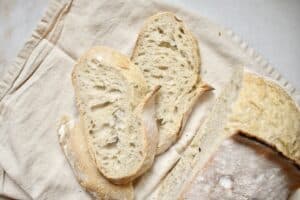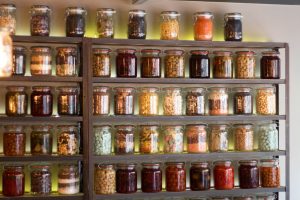Welcome to part 4 of our 7 part series exploring “healthy eating” issues. In case you missed it:
Part 1: Getting Started
Part 2: Eating Healthy When You Never Learned How to Cook
Part 3: Eating Healthy When Limited by Time
Part 4: Eating Healthy When Limited by Money
Part 5: Eating Healthy When Limited by Allergies
Part 6: Eating Healthy When Limited by Picky Eaters
Part 7: Eating Healthy When There Are Multiple Limits to Overcome
Welcome back to Beyond Limits! Today we are going to address the limit of money!
“It’s too expensive” are words I commonly hear when I’m talking to someone about eating healthier. And on the surface, it’s true. Organic food often costs more money to actually purchase, however, that isn’t taking into consideration the value difference of the two items you are getting. Before we get into tips to eating healthy on a budget, let’s talk about food value (aka nutrient density).
Not all food is grown equally. The mass production of food, combined with poor farming practices, has depleted our soil of important nutrients, which causes the food grown in that soil to have less vitamins, minerals and other nutrients in them. And the meat from the animals who eat depleted food from depleted soil (like cows, pigs, chickens) has less nutrition as well.
So what does that mean?
It means you have to eat more food to get the same amount of nutrients.
On the other hand, meat and produce grown with good farming practices has more nutrition, and therefore is more filling than food grown for high-yield. Less will give you more.
So eating nutrient-dense food may be less expensive than you think, because you will get the nutrients you need in less volume.
Nevertheless, I understand the reality of a strict budget. But a strict budget does not mean you can’t buy good food. It just means you have to be creative and wise in how and where you spend your money.
How to Eat Healthy on a Budget
Invest Where it Matters
When you can’t buy all top-quality food, then buy as good as you can. You get the most nutrition out of animal products, so it makes sense to spend a little more money there (remember nutrient dense vs volume). Toxin exposure should also be taken into consideration, and that’s where natural (hormone and antibiotic free) meats, and lists like the Dirty Dozen and Clean 15 can help guide our shopping decisions.
Don’t Buy “Healthy” Junk Food
A “healthier” replacement is not necessarily real food. They are often just as fake (meaning low nutritional value), and usually more expensive!
Go back to the drawing board. Branch out to new recipes that start with whole, real foods as the base. All the recipes that accompany this challenge fall into this category so make sure to try them out!
And remember, nutrient-dense foods fill you up more than empty energy-calories do. So instead of buying expensive “healthy” gluten free, organic pasta, try basing your meal off of soaked rice or a spaghetti squash.
Eat Simple, Local, In-season Foods
Our culture tells us that we have a right to eat an exciting and varied diet with frequent treats and desserts. But these “extras” are often what put us over our budget. The reality is, for most of human history, diets were simple and repetitive. When we want foods from Italy, China and the Pacific Islands all in one week, it makes sense that we can’t afford it. Instead, spend most of your money on simple foods like carrots, onions, ground beef and chicken. Only buy mangos, artichokes, or other seasonal/exotic foods in season and as a special treat.
Increase the Nutrient Density of Filling Foods
For many families on a budget, they turn to eating filling foods like potatoes, beans, rice, pasta and bread. These foods, on their own, are mostly quick but empty calories which spike your blood sugar, get stored as fat, and leave you hungry soon after a meal. However, you can increase the nutrition of these foods by cooking them in meat stock (rice), soaking or sprouting them (grains and beans), and adding LOTS of fat to everything!
Fat keeps you full longer, lessens the blood sugar spike that comes from eating carbs, and allows you to absorb more of the nutrients present in the rice or pasta you ate it with. (For more, read HERE). If you can’t see your teeth marks in the buttered bread you just bit, you didn’t spread it thick enough!
Buy on Sale
Base your meal planning on store sales, using the produce and meats that are on sale that week. Additionally, check with your local store and find out when they mark items for quick-sale. Departments will go through and mark down items that are nearing their expiration date at regular intervals. Find out when they do it, and shop at that time.
Buy in Bulk
You don’t have to be a couponing fanatic to take advantage of buying in bulk. Food co-ops, Costco and Sam’s Club provide great ways to buy in bulk. Also, check to see if there is a discount grocery store in your area.
Another way to buy in bulk is to stock up during a sale. Many stores have cyclical sales, and once you figure out their pattern (feel free to ask them), you can stock up on your commonly used items.
There you have it! Six ways you can purchase more healthy foods on your budget. And remember, when you eat nutrient-dense foods, you save money in the long run!
What do you think of these tips? Do you have others to add?
Make sure to share your recipes with us in the Facebook group.

We reached out to Amy to put together this series of blog posts that we are calling Beyond Limits to provide a little encouragement, and a lot of wisdom, for those of us going through a massive transition with food.
If you are struggling with food allergies, eating more healthfully, or a new way of eating that has been “forced” upon you, please join us:
Join us in Plan to Eat
Amy has put together 15 recipes that are available to you through your Plan to Eat account. Many of these recipes promote healing, some are designed to help avoid common allergens, and some of them are simply to get us in the kitchen cooking real food instead of pulling something out of a box.
All of these recipes are available through the desktop version of your Plan to Eat account by clicking on the Challenges tab and selecting “Beyond Limits” in the dropdown menu.
Join our Facebook group
Do you have a question for Amy? Or maybe you want to connect with others who are going through something similar to you? Our Beyond Limits Facebook Group is a great place to connect with others!
Hint: This is a great place to use the Friends feature to share recipes with other Plan to Eat users!
Join the Beyond Limits Facebook group!







